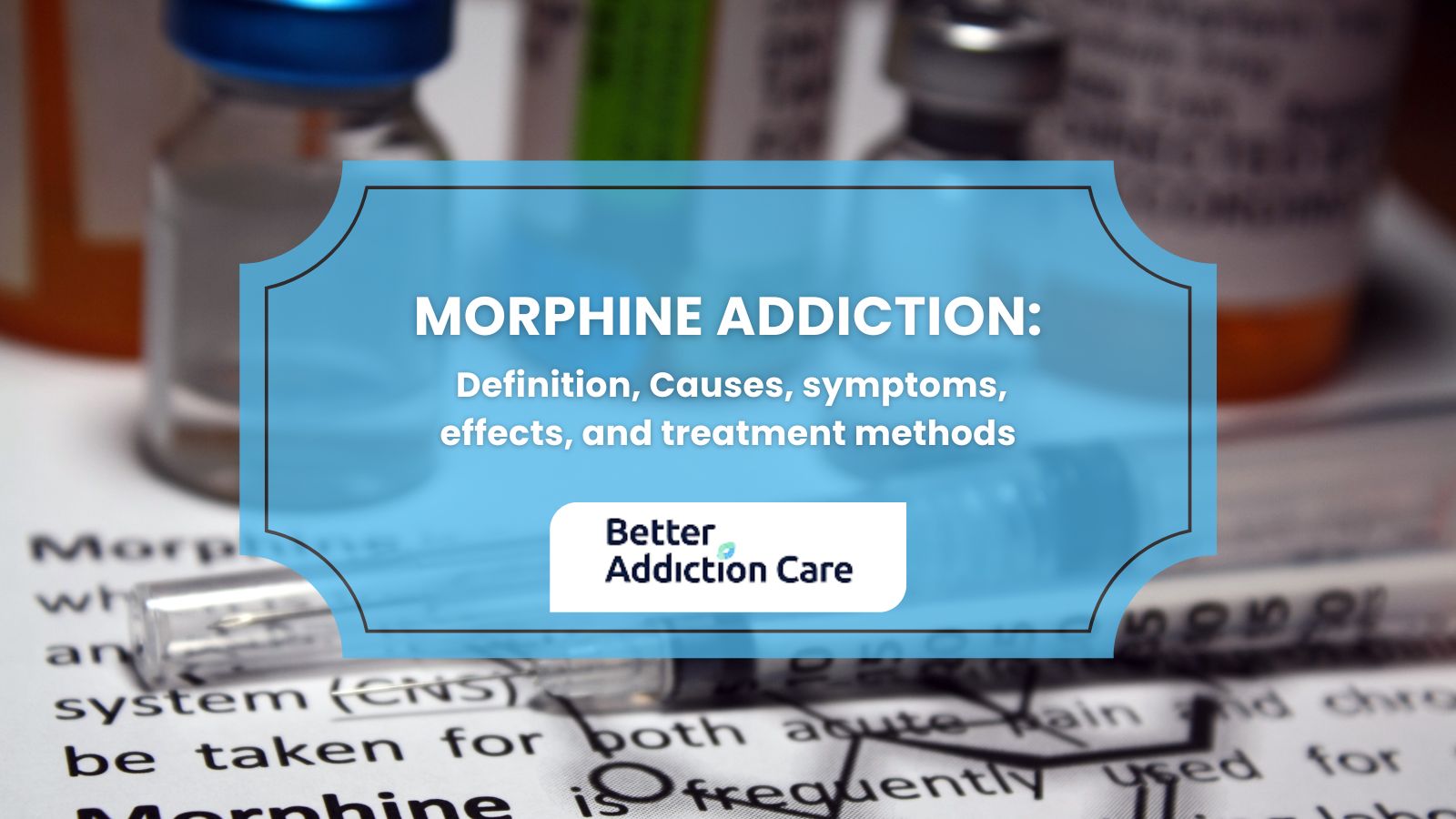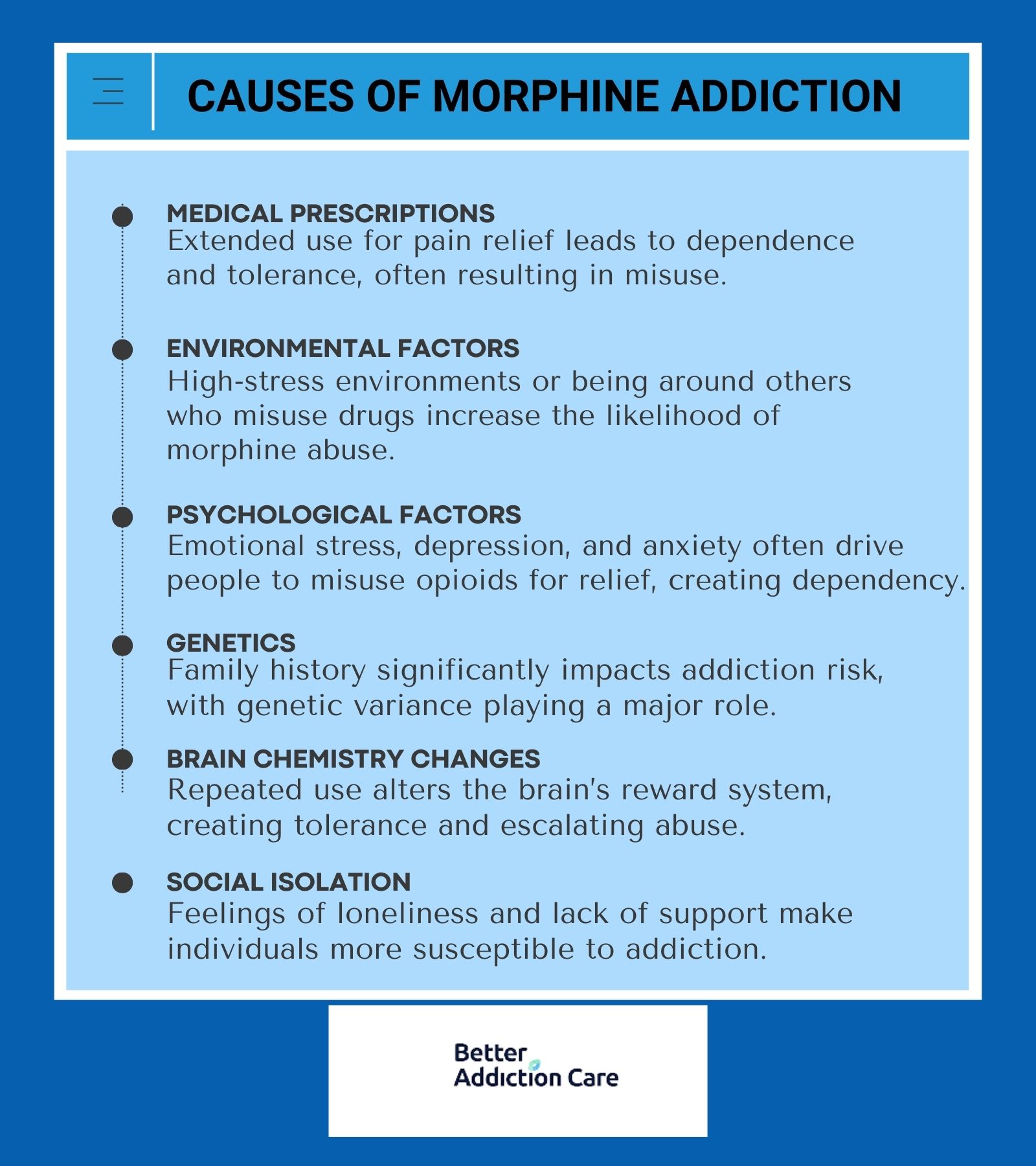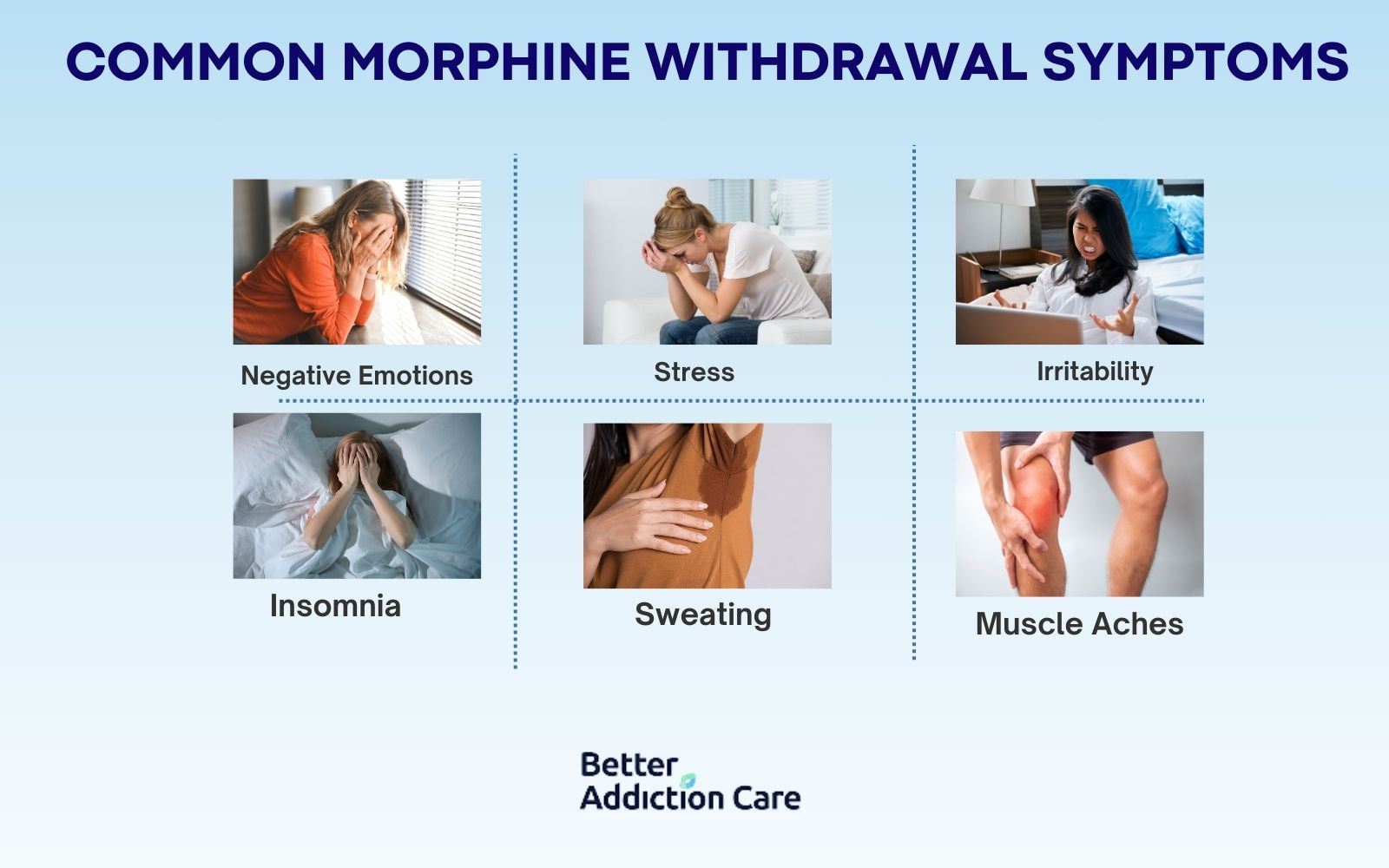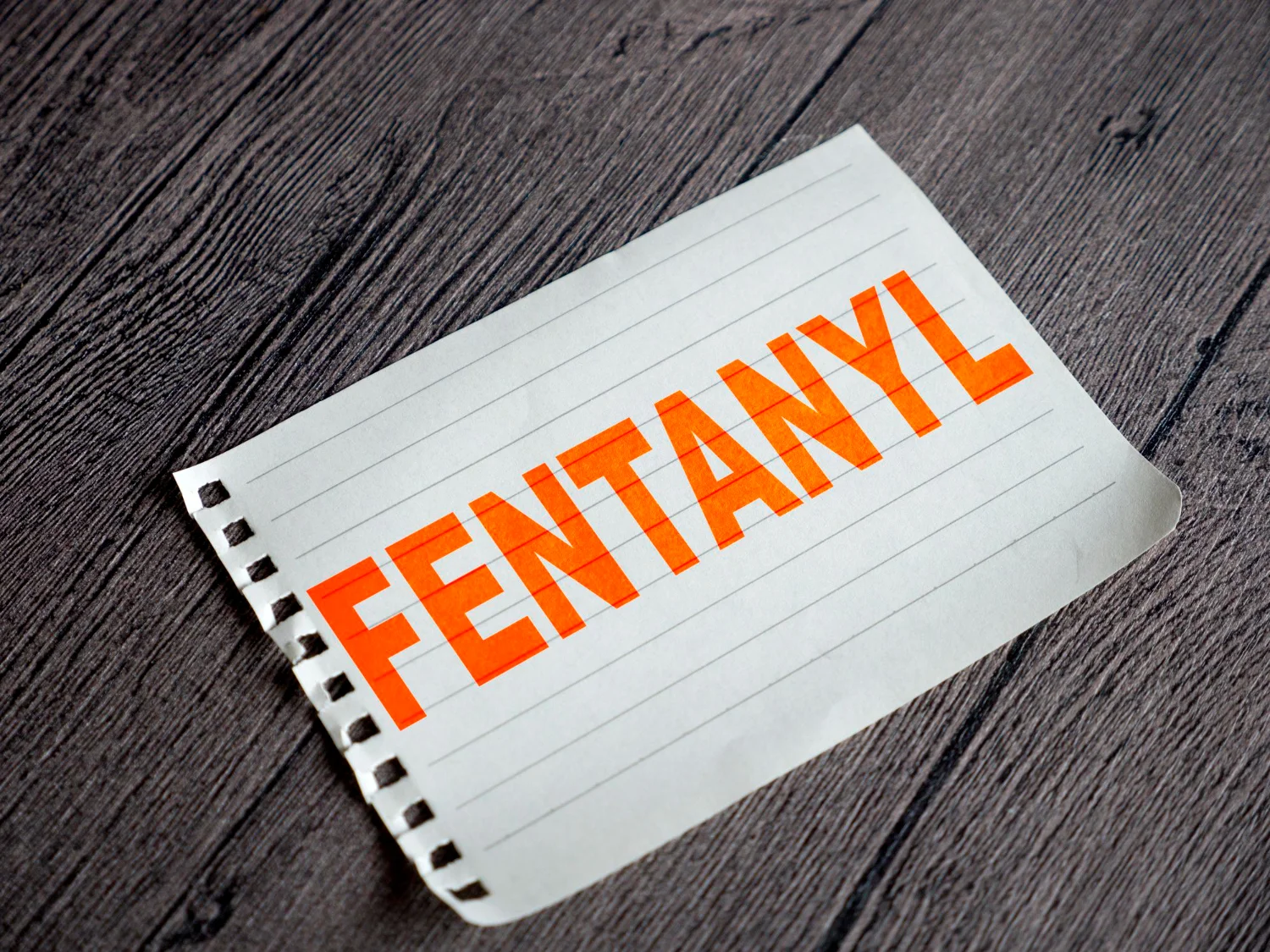Morphine Addiction: Definition, Causes, symptoms, effects, and treatment methods
Morphine addiction develops when your body becomes dependent after prolonged use, especially for chronic pain. As tolerance builds, you need more of the drug to feel the same relief, leading to addiction. In the U.S., heroin-related overdose deaths, linked to opioids like morphine, rose from 3,036 in 2010 to 15,469 in 2016, then dropped to 5,871 by 2022, according to the National Institute on Drug Abuse. These numbers reflect the serious impact of opioid addiction across the country.

Causes of morphine addiction include medical prescriptions for chronic pain, genetic predisposition, psychological and environmental factors, and brain chemistry changes.
The symptoms of morphine addiction include yen sleep, runny nose, slurred speech, itchy skin, euphoria, mood swings, secretive behavior, paranoia, anxiety, and depression.
The short-term and long-term effects of morphine addiction are euphoria, sedation, constipation, respiratory depression, hormonal imbalance, organ damage (liver), overdose, and risk of death, mental health disorder (neurological disorder), altered brain chemistry, auditory hallucinations, and paranoia.
Some of the most common treatment options for morphine addiction are detoxification, cognitive behavioral therapies, medication-assisted treatment, long-term rehabilitation programs(inpatient/outpatient), and support groups.
What is Morphine Addiction?
Morphine addiction is an opioid use disorder that causes compulsive use of morphine, which is an opioid analgesic, despite its harmful consequences. Morphine addiction is classified as a chronic recurrent disease of the central nervous system that leads to personality disorders, comorbidities, and premature death.
In the United States, morphine is classified as a Schedule II drug under the Controlled Substances Act, as it carries a high risk of addiction development but has medical uses as well. Some other common names of morphine are Dreamer, Emsel, MST, Zomorph, MXL, and Sevredol.
What Are The Causes of Morphine Addiction?

The causes of morphine addiction include medical prescriptions for chronic pain relief, environmental factors, psychological factors, genetic factors, changes in brain chemistry, and social isolation.
These causes are described below.
-
Medical Prescriptions for Chronic Pain Relief: Long-term use of morphine for pain relief builds tolerance, leading you to take higher doses and risk addiction.
-
Environmental Factors: Living around people who abuse drugs or in high-stress settings increases the chances of misusing morphine.
-
Psychological Factors: Emotional stress, depression, and anxiety push many toward morphine for relief, creating a cycle of dependence and deeper emotional struggle.
-
Genetic Factors: Genetic factors include a family history of opioid usage. A major fraction of the opioid addiction risk is genetic in origin, and 54% of the liability for opioid addiction was due to genetic variance, according to a study titled “A brief review of the genetics and pharmacogenetics of opioid use disorders” by Wade Berrettini.
-
Changes in Brain Chemistry: Repeated morphine use alters brain chemistry, reducing its effects and pushing you to take more to feel the same relief.
-
Social Isolation: Feeling alone and unsupported increases vulnerability to morphine addiction, as lack of connection disrupts emotional balance and coping.
What Are The Symptoms of Morphine Addiction?

The symptoms of morphine addiction include a combination of physical, behavioral, and psychological signs. These symptoms fall under the criteria provided by the Diagnostic and Statistical Manual of Mental Disorders (DSM-5).
These signs and symptoms of morphine addiction are listed below.
Physical Symptoms of Morphine Addiction
The physical symptoms of morphine addiction are listed below.
-
Yen Sleep: Oversleeping or extreme drowsiness is common with morphine use. Disrupted sleep patterns increase relapse risk and make recovery harder.
-
Runny Nose: Chronic morphine use and withdrawal lead to nasal symptoms like congestion, sneezing, and a persistent runny nose.
-
Slurred Speech: Morphine slows the central nervous system, causing speech to become slow, unclear, and difficult to control.
-
Itchy Skin: Morphine triggers histamine release, leading to flushed skin and persistent itching, especially on the face, neck, and chest.
Behavioral Symptoms of Morphine Addiction
The behavioral symptoms of morphine addiction are listed below.
-
Euphoria: Morphine activates μ-opioid receptors in the brain, triggering intense pleasure and reinforcing drug-seeking behavior.
-
Mood Swings: Without morphine, emotional instability, irritability, and depression occur due to disrupted brain chemistry.
-
Secretive Behavior: People with morphine addiction hide their usage, avoid interaction, and isolate themselves to conceal their dependence.
Psychological Symptoms of Morphine Addiction
The psychological symptoms of morphine addiction are listed below.
-
Paranoia: Prolonged morphine use alters brain chemistry, leading to distrust, fear, and persistent suspicion or delusional thoughts.
-
Anxiety: Morphine disrupts emotional regulation, triggering anxiety during use and withdrawal. Mental tension, restlessness, and worry increase as the brain adapts to the drug.
-
Depression: Constant morphine intake interferes with dopamine and serotonin levels, causing emotional numbness, hopelessness, and long-term depressive symptoms.
What Are The Effects of Morphine Addiction?

The effects of morphine addiction include short-term (euphoria, sedation, and constipation), long-term physical (respiratory depression, hormonal imbalance, and organ damage), and long-term psychological effects (mental health disorders, paranoia, and altered brain chemistry).
These effects are described below.
Short-Term Effects
The short-term effects of morphine addiction are euphoria, sedation, constipation, and nausea.
These effects are listed below.
-
Euphoria: Euphoria is a feeling that is produced when morphine and other opioids trigger the brain’s reward system and cause intense sensations of pleasure and relaxation. Activation of the μ-opioid receptor by an agonist such as morphine causes euphoria and an intense feeling of pleasure.
-
Sedation: Morphine slows the central nervous system, causing drowsiness and reduced mental and physical function.
-
Constipation: Constipation occurs when compulsive morphine usage slows down the body’s gastrointestinal motility and causes digestion problems. Opioid-induced constipation (OIC) accounts for over 40% to 60% of patients without cancer receiving opioids, according to the study titled ”Opioid-Induced Constipation” by Omeed Sizar.
-
Nausea: Nausea is caused when morphine affects the brain’s chemoreceptor trigger zone, causing intense feelings of vomiting and sickness. A systematic review of randomized controlled trials of opioids for chronic noncancer pain reported that 32% of patients developed nausea and 15% developed vomiting, according to research titled “Opioid-induced nausea and vomiting” by the Albany Medical College.
Long-Term Physical Effects
The long-term physical effects of morphine addiction are respiratory depression, hormonal imbalance, organ damage, and overdose risk.
These effects are listed below.
-
Respiratory Depression: Respiratory depression is dangerously slow or shallow breathing. Individuals with chronic morphine addiction damage their respiratory organs and tend to suffer from breathing problems. Respiratory depression (RD) is the primary cause of death due to opioids, according to the title: “Current research in pathophysiology of opioid-induced respiratory depression, neonatal opioid withdrawal syndrome, and neonatal antidepressant exposure syndrome” by Brian A Baldo.
-
Hormonal Imbalance: Morphine disrupts hormone production, lowering testosterone and estrogen. It also alters levels of GH, prolactin, and oxytocin, affecting mood, energy, and reproductive health.
-
Organ Damage(liver): Prolonged morphine use strains the liver, leading to inflammation or failure. In high doses, it contributes to acute liver injury and impacts other organs.
- Endocrine Effects: Morphine causes adrenal gland problems, including adrenal insufficiency, which manifests as dizziness, fainting, loss of appetite, unusual tiredness, and skin changes. It also leads to infertility and menstrual irregularities, such as absent or irregular periods. According to Wikipedia, up to 90% of long-term opioid users develop opioid-induced hypogonadism, a condition that affects both sexes and is associated with decreased libido and increased risk of osteoporosis.
- Immune System Effects: Morphine suppresses immune function, including natural killer cell activity, increasing susceptibility to infections and other diseases. According to Wang, Q.’s 2022 study, ‘Morphine suppresses the immune function of lung cancer by up-regulating MAEL expressi’, Morphine suppresses immune function by increasing immunosuppressive factors (PD-L1, TGF-β, IL-10) while decreasing immune-enhancing IL-2 and reducing CD8+ T cell activity.
-
Overdose Risk: Overdose risk rises when the body develops a tolerance for morphine usage and the individual does not feel the same effects as they used to. This forces them to take more or heavier doses, eventually further damaging their health and overdosing.
Long-Term Psychological Effects
The long-term psychological effects of morphine addiction are mental health disorders (Neurological Disorders), altered brain chemistry, auditory hallucinations, and paranoia.
These effects are listed below.
-
Mental Health Disorders (Neurological Disorders): Mental health and neurological disorders like anxiety, depression, and stress are linked to long-term morphine usage. A link was found between prescription opioid use and negative mental health consequences such as anxiety, according to research titled: “Mood and Anxiety Symptoms in Persons Taking Prescription Opioids: A Systematic Review with Meta-Analyses of Longitudinal Studies” by Janni Leung.
-
Altered Brain Chemistry: Altered brain chemistry is caused by changes in the brain’s natural chemical balance due to prolonged morphine addiction. It reduces the brain’s ability to produce dopamine and serotonin. Brain abnormalities resulting from chronic use of morphine-derived drugs are underlying causes of opioid dependence, according to a study titled: “The Neurobiology of Opioid Dependence: Implications for Treatment” by Thomas R Kosten.
-
Auditory Hallucinations: Auditory hallucinations are hearing sounds and voices that are not physically present. Individuals with morphine addiction suffer from this as the opioid has negative effects on the sensory processing of the brain.
-
Paranoia: Paranoia occurs when an individual starts building up feelings of distrust, suspicion, and fear due to prolonged morphine addiction. People have a hard time socializing and develop a fear of talking and sharing feelings with others.
What Are The Treatment Methods for Morphine Addiction?
The treatment options for morphine addiction include detoxification, cognitive behavioral therapy, medication-assisted treatment, long-term rehabilitation programs, support groups, and holistic therapies.
Here are the key treatment methods for Morphine addiction:
Detoxification
Detox is the first step to flush morphine from the body under 24/7 medical supervision. It helps ease withdrawal but does not treat the mental side of addiction. Detox usually lasts up to two weeks.
Cognitive Behavioral Therapy
CBT helps rewire harmful thoughts and behaviors tied to drug use. It works well in both group and individual settings and lowers relapse risk. Treatment takes 12 to 16 weeks and requires commitment.
Medication-Assisted Treatment
The medication-assisted treatment approach uses drugs like methadone, buprenorphine, and naltrexone to reduce cravings and withdrawal. It's effective but needs close monitoring and leads to medication dependence. Treatment runs 6 to 12 months.
Long-Term Rehab (Inpatient/Outpatient)
Inpatient rehab gives full-time care; outpatient allows you to live at home while attending treatment. These programs offer strong support but demand time and money. Duration ranges from 1 to 3 months.
Support groups
Support groups connect people facing morphine addiction. They offer emotional support, shared advice, and motivation. These groups are ongoing and free, but work best alongside other treatments.
Holistic Therapies
Yoga, art therapy, and acupuncture reduce stress and boost emotional health. These therapies don’t replace medical treatment but give you healthy outlets and balance during recovery.
What Are The Withdrawal Symptoms of Morphine Addiction?

The withdrawal symptoms of morphine addiction are negative emotions, stress, irritability, insomnia, sweating, and muscle aches. Morphine withdrawal is the physical and psychological response of the body to suddenly reducing or stopping morphine use after prolonged use.
Can Morphine And Cocaine Produce Feelings Of Euphoria?
Yes, both morphine and cocaine can produce feelings of euphoria, but in different ways. Morphine acts on opioid receptors to block pain and release dopamine. Cocaine stimulates dopamine release and gives an intense, short-lived euphoria that leads to cocaine addiction.
Is The Addiction Potential Of Fentanyl Higher Than That Of Morphine?
Yes, the addiction potential of fentanyl is higher than morphine. Fentanyl is much more potent and acts on the brain's opioid receptors at up to 100 times the strength of morphine, which makes fentanyl addiction more potent.
Are Morphine And Heroin Derived From Opium?
Yes, both morphine and heroin are derived from opium. Morphine is a natural component of opium, while heroin is a synthetic version of morphine. This relationship makes heroin addiction similar to morphine addiction, as both drugs act on the brain’s opioid receptors to produce pain relief and euphoria.
How To Know If Local Drug Rehab Facilities Offer Treatment For Morphine Addiction?
To know if local drug rehab facilities offer treatment for morphine addiction, contact facilities directly to inquire about their specialized opioid addiction programs. Ask specifically about medical detox services, medication-assisted treatment (MAT) options, and staff credentials in treating opioid use disorders, as morphine addiction requires specialized care due to physical dependence and withdrawal symptoms.
Our comprehensive rehab locator tool helps you easily find and compare Drug Rehab Facilities in your area that specialize in morphine addiction treatment, allowing you to filter by specific services and insurance acceptance. Verify the facility's treatment approaches, check online reviews, and confirm insurance coverage to ensure you find a reputable center with proven experience in opioid addiction recovery.
How To Know If My Insurance Covers Morphine Addiction Treatment?
To know if your insurance covers morphine addiction treatment, start by reviewing your policy documents or contacting your insurance provider directly. Most insurance plans are required to cover substance use disorder treatment as an essential health benefit under the Affordable Care Act, which typically includes detoxification services, inpatient and outpatient rehabilitation programs, medication-assisted treatment (MAT), and counseling services specifically for morphine addiction.
The easiest way to confirm your coverage is to verify your insurance through a professional service that provides clear details about what treatments are covered, your out-of-pocket costs, and which treatment centers are in your network. Don't let uncertainty about insurance coverage delay getting help—professional verification services quickly clarify your benefits and help you access the morphine addiction treatment you need.







